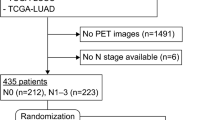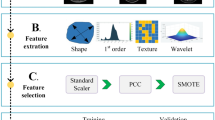Abstract
In order to analyse the application value of U-Net neural network in reconstruction and diagnosis of computed tomography (CT) scanning image of lung cancer and provide assistance for CT image diagnosis of lung cancer, a new deep learning-based tumour image diagnosis algorithm U-Net-NT (U-Net-Newton’s method) was constructed based on the U-Net neural network framework and compared with genetic algorithm-back propagation (GA-BP), random forest (RF), Semi-Naive Bayesian (SNB), and filtered back projection (FBP). In addition, the information given by experts was taken as a control, set as D0 group. Tumour disappearance rate (TDR), maximum standard uptake value (SUVmax), and metabolic tumour volume (MTV) were calculated with True D. The results showed that the diagnosis results on primary lesion density, SUVmax, and MTV level in the GA-BP group, RF group, SNB group, and FBP group were significantly lower than that in the D0 group (P < 0.05); the diagnosis results of primary lesion density, SUVmax, and MTV level in the U-Net-NT group had no obvious difference with the D0 group (P > 0.05); the U-Net-NT group had a significantly higher Dice coefficient than the GA-BP group, the RF group, SNB group, and FBP group, and the differences were statistically significant (P < 0.05); the volumetric overlap error (VOE) and running time in the U-Net-NT group were observably lower than those in the GA-BP group, RF group, SNB group and FBP group, and the differences were statistically significant (P < 0.05); the accuracy, sensitivity, and specificity for the diagnosis of primary lesion lymph node metastasis, pleural metastasis, and bone metastasis in the U-Net-NT group were not significantly different from those in the GA-BP group, RF group, and SNB group, FBP group (P > 0.05), and the accuracy, sensitivity, and specificity for the diagnosis of primary lesion brain metastasis and liver metastasis were higher than those in the GA-BP group, RF group, SNB group, and FBP group significantly (P < 0.05). In short, the new deep learning-based U-Net-NT algorithm constructed in this study is more excellent in the accuracy, sensitivity, and specificity for the diagnosis of the primary lesion level and metastasis and has better quality of reconstructed image.







Similar content being viewed by others
References
Moitra D, Mandal RK (2019) Automated AJCC staging of non-small cell lung cancer (NSCLC) using deep convolutional neural network (CNN) and recurrent neural network (RNN). Health Inf Sci Syst 7(1):14
Wang C, Li H, Jiaerken Y et al (2019) Building CT radiomics-based models for preoperatively predicting malignant potential and mitotic count of gastrointestinal stromal tumors. Trans Oncol 12(9):1229–1236
Desseroit MC, Tixier F, Weber WA et al (2018) Reliability of PET/CT shape and heterogeneity features in functional and morphologic components of non–small cell lung cancer tumors: a repeatability analysis in a prospective multicenter cohort. J Nucl Med 58(3):406–411
Engstrand J, Toporek G, Harbut P et al (2017) Stereotactic CT-guided percutaneous microwave ablation of liver tumors with the use of high-frequency jet ventilation: an accuracy and procedural safety study. Am J Roentgenol 208(1):193–200
Ijaz MF, Attique M, Son Y (2020) Data-driven cervical cancer prediction model with outlier detection and over-sampling methods. Sensors (Basel) 20(10):2809
Wei P, Chen J, Hu Y et al (2016) Dendrimer-Stabilized gold nanostars as a multifunctional theranostic nanoplatform for CT imaging, photothermal therapy, and gene silencing of tumors. Adv Healthcare Mater 5(24):3203–3213
Lv Z, Li X, Wang W et al (2018) Government affairs service platform for smart city. Futur Gener Comput Syst 81:443–451
Yang HQ, Zhang L, Xue J et al (2019) Unsaturated soil slope characterization with Karhunen-Loève and polynomial chaos via Bayesian approach. Eng Comput 35(1):337–350
Baid U, Talbar S, Rane S et al (2018) Deep learning radiomics algorithm for gliomas (drag) model: a novel approach using 3d unet based deep convolutional neural network for predicting survival in gliomas. International MICCAI Brainlesion Workshop 11384:369–379
Tamang J et al (2021) Dynamical properties of ion-acoustic waves in space plasma and its application to image encryption. IEEE Access 9:18762–187882
Tong C, Liang B, Zhang M et al (2020) Pulmonary nodule detection based on ISODATA-Improved faster RCNN and 3D-CNN with focal loss. ACM Trans Multimedia Comput Commun Appl (TOMM) 16(1):1–9
Zhang S, Han F, Liang Z et al (2019) An investigation of CNN models for differentiating malignant from benign lesions using small pathologically proven datasets. Comput Med Imag Graph 77:101645
Toğaçar M, Ergen B, Cömert Z (2020) Detection of lung cancer on chest CT images using minimum redundancy maximum relevance feature selection method with convolutional neural networks. Biocybernet Biomed Eng 40(1):23–39
Han SS, Kim MS, Lim W et al (2018) Classification of the clinical images for benign and malignant cutaneous tumors using a deep learning algorithm. J Investig Dermatol 138(7):1529–1538
Chowdhary CL, Patel PV, Kathrotia KJ et al (2020) Analytical study of hybrid techniques for image encryption and decryption. Sensors (Basel) 20(18):5162
Li D, Zhang Y, Wen S et al (2016) Construction of polydopamine-coated gold nanostars for CT imaging and enhanced photothermal therapy of tumors: an innovative theranostic strategy. J Mater Chem B 4(23):4216–4226
Trivizakis E, Manikis GC, Nikiforaki K et al (2018) Extending 2-D convolutional neural networks to 3-D for advancing deep learning cancer classification with application to MRI liver tumor differentiation. IEEE J Biomed Health Inform 23(3):923–930
Skoura E, Michopoulou S, Mohmaduvesh M et al (2016) The impact of 68Ga-DOTATATE PET/CT imaging on management of patients with neuroendocrine tumors: experience from a national referral center in the United Kingdom. J Nucl Med 57(1):34–40
Djuric U, Zadeh G, Aldape K et al (2017) Precision histology: how deep learning is poised to revitalize histomorphology for personalized cancer care. NPJ Precis Oncol 1(1):1–5
Kadam VJ, Jadhav SM, Vijayakumar K (2019) Breast cancer diagnosis using feature ensemble learning based on stacked sparse autoencoders and softmax regression. J Med Syst 43(8):263
Hussein S, Kandel P, Bolan CW et al (2019) Lung and pancreatic tumor characterization in the deep learning era: novel supervised and unsupervised learning approaches. IEEE Trans Med Imaging 38(8):1777–1787
Bouget D, Jørgensen A, Kiss G et al (2019) Semantic segmentation and detection of mediastinal lymph nodes and anatomical structures in CT data for lung cancer staging. Int J Comput Assist Radiol Surg 14(6):977–986
Shaish H, Mutasa S, Makkar J et al (2019) Prediction of lymph node maximum standardized uptake value in patients with cancer using a 3D convolutional neural network: a proof-of-concept study. Am J Roentgenol 212(2):238–244
Wang H, Zhou Z, Li Y et al (2017) Comparison of machine learning methods for classifying mediastinal lymph node metastasis of non-small cell lung cancer from 18 F-FDG PET/CT images. EJNMMI Res 7(1):11
Kong SH, Haouchine N, Soares R et al (2017) Robust augmented reality registration method for localization of solid organs’ tumors using CT-derived virtual biomechanical model and fluorescent fiducials. Surg Endosc 31(7):2863–2871
Seo H, Huang C, Bassenne M, Xiao R et al (2019) Modified U-Net (mU-Net) with incorporation of object-dependent high level features for improved liver and liver-tumor segmentation in CT images. IEEE Trans Med Imag 39(5):1316–1325
Lu MT, Raghu VK, Mayrhofer T et al (2020) Deep learning using chest radiographs to identify high-risk smokers for lung cancer screening computed tomography: development and validation of a prediction model. Ann Intern Med 173(9):704–713
Men K, Boimel P, Janopaul-Naylor J et al (2018) Cascaded atrous convolution and spatial pyramid pooling for more accurate tumor target segmentation for rectal cancer radiotherapy. Phys Med Biol 63(18):185016
Chen M, Gong D (2019) Discrimination of breast tumors in ultrasonic images using an ensemble classifier based on TensorFlow framework with feature selection. J Investig Med 67(Suppl 1):A3. https://doi.org/10.1136/jim-2019-000994.9
Zheng Y, Zhou Y, Lai Q (2015) Effects of twenty-four move shadow boxing combined with psychosomatic relaxation on depression and anxiety in patients with type-2 diabetes. Psychiatr Danub 27(2):174
Author information
Authors and Affiliations
Corresponding author
Additional information
Publisher's Note
Springer Nature remains neutral with regard to jurisdictional claims in published maps and institutional affiliations.
Rights and permissions
About this article
Cite this article
Hou, S. Auxiliary tumour diagnosis image with deep learning technology. J Supercomput 78, 578–595 (2022). https://doi.org/10.1007/s11227-021-03881-7
Accepted:
Published:
Issue Date:
DOI: https://doi.org/10.1007/s11227-021-03881-7




